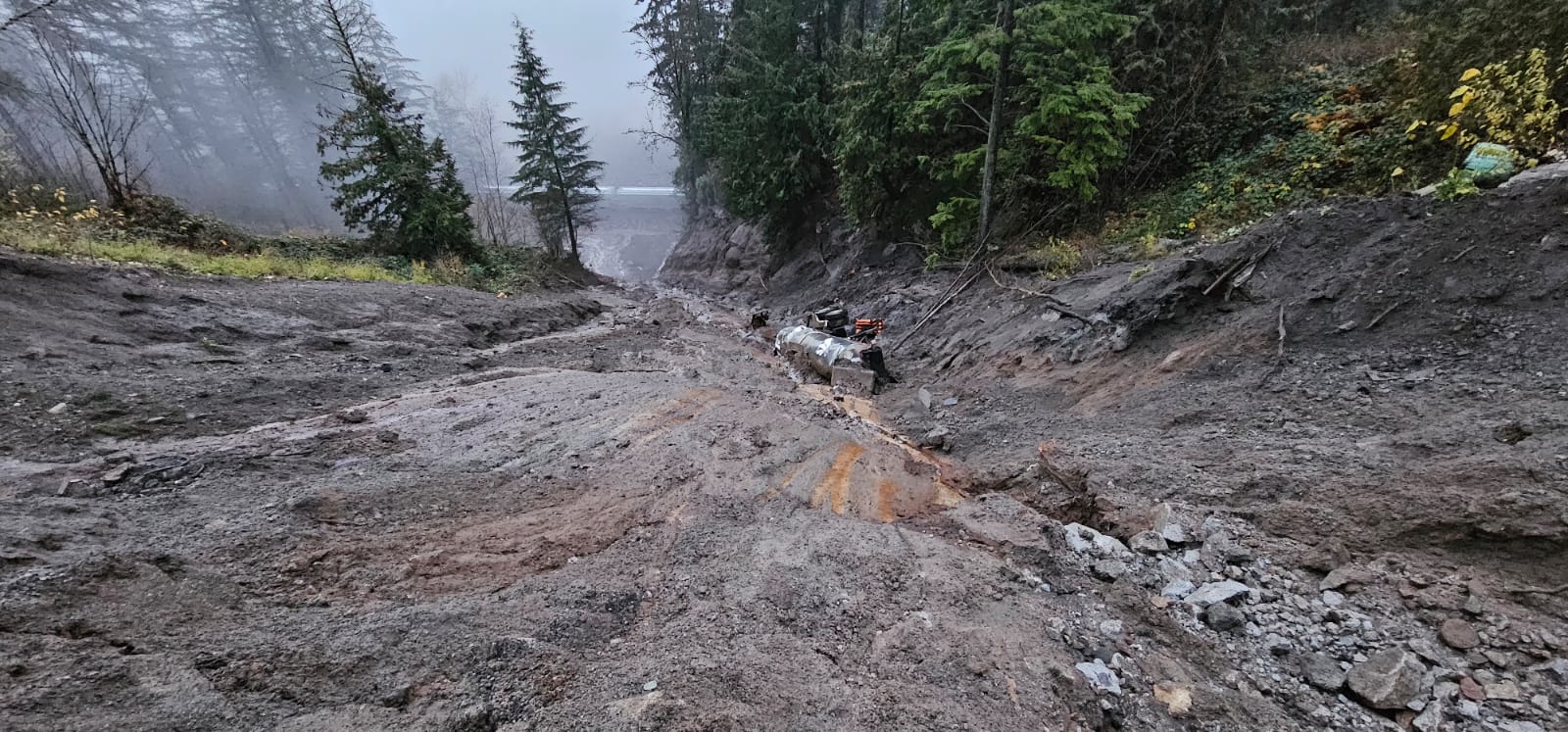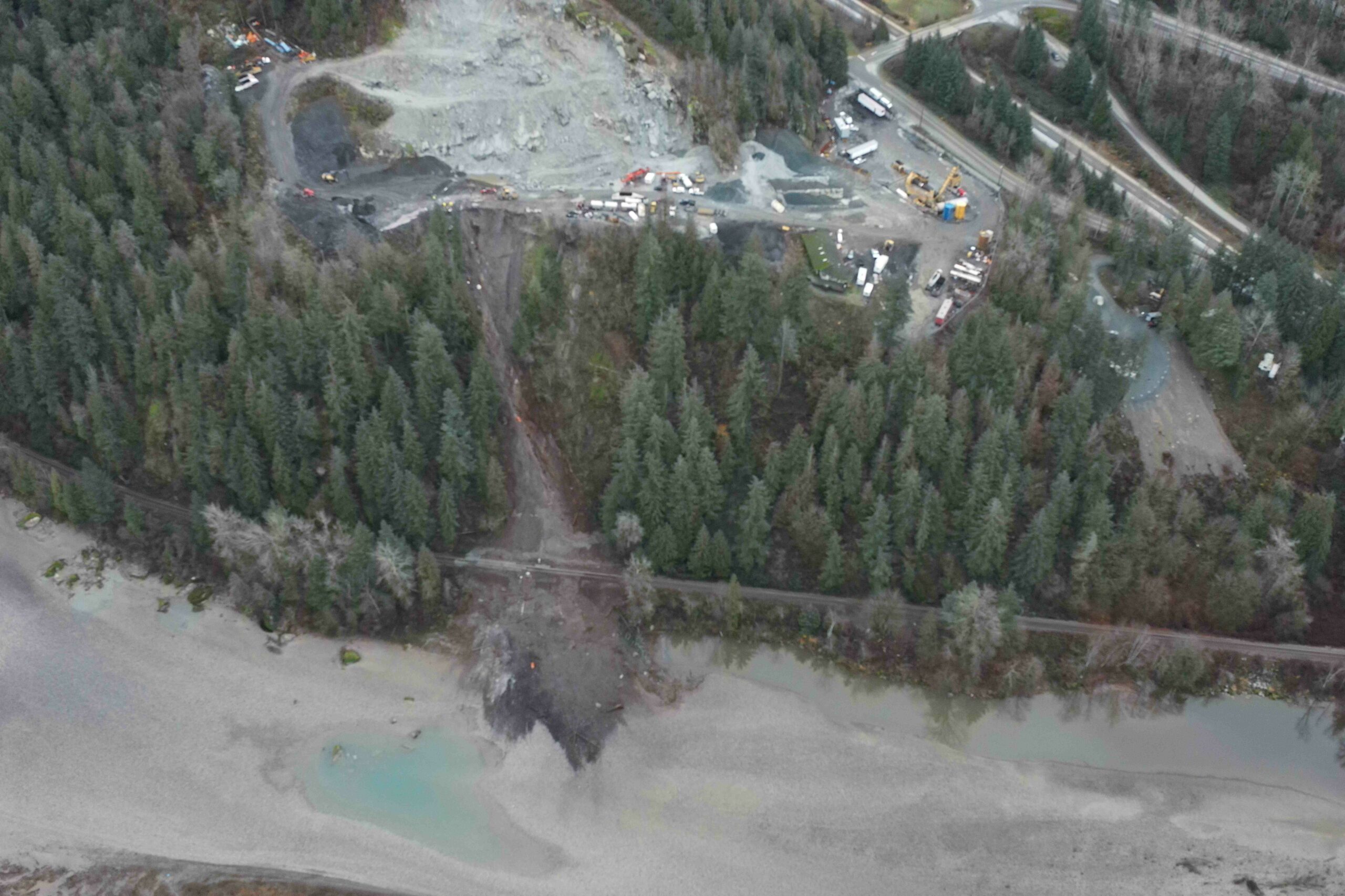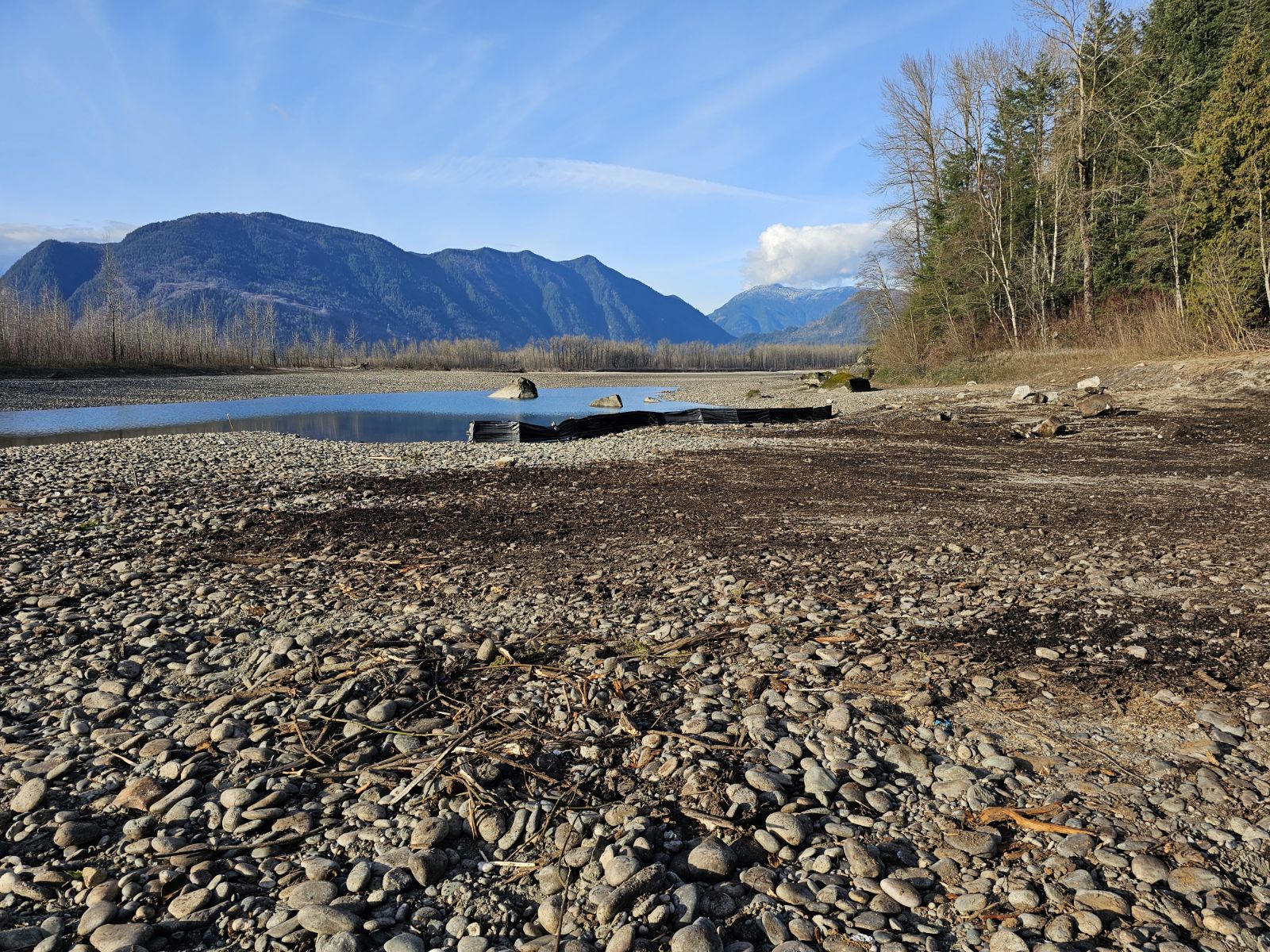
Two blank cheques: are Ontario and B.C. copying the homework?
Governments of the two provinces have eerily similar plans to give themselves new powers to...
First Nations leaders say they have been waiting nearly three months for a private asphalt company to clean up an early December oil spill reported in Hope, B.C., near the Fraser River on Stó:lō land.
Nearly two months after the incident, on Feb. 2, a manager from the enforcement division of B.C.’s Ministry of Environment and Climate Change issued warnings to a director of the company, Keywest Asphalt, that they could face up to six months in prison and a fine of up to $300,000 if convicted of violating the province’s Environmental Management Act.
In one warning letter, dated Jan. 29, the ministry alleged the company was violating the act and had not taken sufficient actions to clean up the spill, despite being directed to do so in December.
The spill was triggered by a landslide that knocked over a tanker truck container on the slope of the company’s rock quarry, impacting prime sturgeon habitat, according to Takoda Castonguay, community support assistant with the Emergency Planning Secretariat, an organization supporting rapid response for 31 Coast Salish First Nations.
The apparent delays in cleanup response are now threatening the start of sturgeon season, which First Nations leaders say begins on Feb. 28 as the fish return to the river. That’s the same day the company’s permit to access the riverbed under Fisheries and Oceans Canada regulations is also slated to expire. The B.C. Ministry of Environment and Climate Change Strategy told The Narwhal permits expire at the end of February due to spring thaw that will cause the river to rise, and said the permit can be extended.
Sources told The Narwhal the landslide happened between Dec. 5 and 6. The ministry of environment told The Narwhal it was observed on Dec. 6 by a CN Rail employee, who reported it on Dec. 7 through the public spill reporting line. According to provincial documents the company reported the spill on Dec 7. First Nations leaders and community responders say they were told by Keywest and a remediation company that a response would take two weeks.
But the cleanup did not begin in earnest until Feb. 23, almost three months later, according to the sources. They say it remains unclear how much oil spilled or may have leached into the groundwater.
Officials from the company did not respond to requests for comment from The Narwhal.
According to the First Nations leaders, the container stopped partway down the slope, but landslide debris spilled on the Canadian National Railway (CN Rail) and reached the river. Castonguay — who said he has been leading calls between local First Nations, the province and the company — says the maximum estimate for the spill was about 2,000 litres.
Tyrone McNeil, Stó:lō Tribal Council president and Tribal Chief and chair of the Emergency Planning Secretariat, said things have been moving at “a snail’s pace.”
He said it took two weeks to get the first geotechnical report from the environmental company Keywest (also referred to in company documents as Key-West Asphalt (333) Ltd and Key-West Asphalt Products) hired. “Considering that it shut down CN Railway, considering there’s oil on the land, considering there’s deleterious material in the water, that was about 10 days later than I expected,” he said.
Janice Parsey, director of intergovernmental affairs for Seabird Island Band, said she and others have been stressed thinking about the channel starting to fill in with spring freshet. The cleanup has been delayed numerous times.
“The window is really closing in,” Parsey said.

On Feb. 13, the Tiyt Tribe, which consists of Chawathil First Nation, Shxw’owhamel First Nation, Peters Band, Popkum First Nation, Union Bar, Sq’ewa:lxw First Nation, Yale First Nation and Seabird Island, declared a state of emergency. They notified Minister of Environment and Climate Change Strategy George Heyman and Minister of Emergency Management and Climate Readiness Bowinn Ma.
In a letter to the ministers, the leaders said they had been on daily update calls organized by the Emergency Planning Secretariat and “on each call there was indication the cleanup would occur the following day, this still has not occurred.”
They urged the ministers to use emergency measures in the Environmental Management Act to expedite the cleanup, instead of leaving it up to Keywest and the firm it hired.
“For some reason, it’s not taken seriously,” Chief Jim Harris of Seabird Island Band said in an interview.” He said the ministries involved seemed to be “passing off responsibility.”
Leaders told The Narwhal that Keywest had switched environmental remediation companies, which caused some delay, including the new company needing to do its own geotechnical report.
The environment ministry confirmed work was delayed due to slope stability concerns, which necessitated a geotechnical report in advance of cleanup and restoration. “Worker safety is paramount and geotechnical work is complicated requiring qualified professionals and it was completed near the end of January,” a spokesperson told The Narwhal.
Castonguay and First Nations leaders told The Narwhal that Keywest also cited weather as a reason for delays, because the work can’t be done in the rain, even though it’s been an uncharacteristically dry winter. Castonguay said that often, the remediation experts Keywest hired have not been present on phone calls and so leaders aren’t getting the details they’re looking for.
Sally Hope, councillor for Seabird Island Band, said it’s been “a messy process.” The company has been given deadlines they haven’t met, she said. And the whole time, she worried about each rainfall pushing the unknown amount of oil into the ground.
“It gets really frustrating that the enforcement is not there,” she said.
The provincial ministries of environment, mines, and emergency preparedness all have roles to play. As well, the landslide crossed Crown land, bringing CN Rail and Fisheries and Oceans Canada into the mix — making the whole thing “a bit convoluted,” McNeil said.
CN Rail confirmed it cleared debris off the track “as it posed a safety risk.”
“However, the debris remained on CN property and our crews are coordinating with Keywest contractors and government officials on their clean up activities in the area,” Tyler Banick, manager of public affairs at CN Rail, told The Narwhal in an email.
“We can’t have regulators tripping over themselves without anybody even having an inclination to want to take the lead,” Castonguay said. “I don’t like to give outs to the responsible party for just how crazy this has gone. But I do think if our regulators can’t decide who’s in charge and navigate all of the different regulations, they have to understand — how can we expect the responsible party to understand that?”
McNeil wants to see a system overhaul — including changing how the province relies on the responsible company to hire a remediation company. As good as the remediation company may be, they wind up beholden to their client that’s hired them, he argued. Instead of only relying on the responsible party and the consultants they’ve hired, he wants to see third-party experts, or more capacity with the province or First Nations to get experts on the grounds themselves.
A report from the auditor general of British Columbia, released on Tuesday, identified “shortcomings and deficiencies” in the province’s response to hazardous spills.
The auditor general found B.C. lacks a provincial-level plan for responding to major spills, does not consistently notify First Nations, and had about $13.9 million of spill-related costs outstanding at the end of February 2023.
The ministry of environment told The Narwhal that through B.C.’s public interest bonding strategy, they are “working to ensure owners of high-risk industrial projects have the financial resources in place so that they – not British Columbians – pay the full costs of environmental cleanup, even if their projects are abandoned.”
When asked about community concerns regarding shortcomings in the spill response, the ministry of environment responded that B.C.’s emergency response system is guided by “the polluter pays principle,” and emphasized Keywest is responsible for restoration while B.C.’s role is to ensure remediation is completed.


Leaders are left demanding better responses for future emergencies.
“People seem to be either passing the buck or, or just saying they can’t do anything. And it’s very disturbing.” Eddie Gardner, councillor for Sqwá First Nation, told The Narwhal. He said the situation sheds light on preventing mistakes in the future.
“A greater involvement of Indigenous governments need to be included in the regulations and the response,” he said.
Jeanie Kay-Moreno, executive assistant for Chawathil First Nation, said the spill response was “really disappointing.”
“It seems like they’re waiting for the weather to start and the water to come up and just to take it away,” she said. “It seems like ‘hurry up and wait.’ And it’s hurtful to see that happen.”
She brought up her ancestors’ saying, s’ólh témèxw te ikw’el’ó. xólhmet te mékw’stám it kewlát — “this is our land, we have to take care of everything that belongs to us.”
In the 1990s, Stó:lō fishers began to notice sturgeon decline, and self-imposed a moratorium on fishing.
“Sturgeon are a traditional food for our people. They have a medicine in them, in the backbone,” Hope said. “For at least three decades we haven’t been able to harvest those and pass those teachings down to our young ones.”
Multiple factors, including climate change, low water and sedimentation are all impacting sturgeon.
The Herrling Channel, where the landslide took place, is prime sturgeon spawning habitat, McNeil explained. Sturgeon lay their eggs at the deep part of the channel, and the eggs attach to big rocks. As they grow, they hide under the rocks from predators, he said. The habitat is already being impacted by other factors, like logging practices. Mature trees stabilize soil and retain water. With fewer mature trees, rivers are rushing and scooping up more gravel along the way, which is carried down river.
“The influx of gravel literally buries the sturgeon,” McNeil said. The freshly developed larvae that were safe under the big rock are buried in gravel and unable to drift downstream and grow to their next life phase. He fears the additional damage from the landslide makes the situation for sturgeon even more serious.
McNeil said he’s pushing to have the lower Fraser River population of white sturgeon listed as endangered under the federal Species At Risk Act, and halt the sports fishery to allow them to rebuild.
“The number one priority right now has to be stabilizing the population,” he said.
Castonguay said they “desperately” need an after-action review of how this cleanup was handled, which McNeil said he will be coordinating.
“I think the initial response could have been done faster if everybody had been on the same page, a sense of unified command could have been put in place,” Castonguay said.
“My main takeaway is that we need a cleaner approach … The main issue right now is getting all the parties to communicate better.”
Updated Feb. 28, 2024, at 3:45 p.m. PT: This story was updated to include a statement from the B.C. Ministry of Environment and Climate Change Strategy.
Updated Mar. 6, 2:50 p.m. PT: This story was updated with Jeanie Kay-Moreno’s current job title. She was previously a councillor with Chawathil First Nation and is currently an executive assistant.
Get the inside scoop on The Narwhal’s environment and climate reporting by signing up for our free newsletter. On a warm September evening nearly 15...
Continue reading
Governments of the two provinces have eerily similar plans to give themselves new powers to...

Katzie First Nation wants BC Hydro to let more water into the Fraser region's Alouette...

Premier David Eby says new legislation won’t degrade environmental protections or Indigenous Rights. Critics warn...
